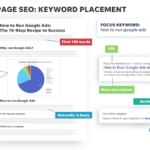E-commerce is growing fast. Knowing the right metrics is crucial.
In 2025, tracking the right e-commerce metrics can make or break your business. With so much data available, it’s easy to get lost. Which numbers truly matter? Understanding key metrics helps you make smart decisions and stay ahead. Whether you’re a small shop or a large enterprise, focusing on the right data is essential.
This blog will guide you through the most important e-commerce metrics to track in 2025. Learn how these metrics can boost your business and keep you competitive. Get ready to dive into the world of e-commerce analytics and see how they can shape your future success.

Credit: www.convertcart.com
Table of Contents
ToggleIntroduction To E-commerce Metrics
Tracking e-commerce metrics is crucial for any online business. Metrics give you insights into your store’s performance. They help you understand customer behavior. By monitoring these numbers, you can make data-driven decisions.
In 2025, the e-commerce landscape will be more competitive. To stay ahead, you must track the right metrics. Knowing what to measure can improve your strategy and boost your sales.
Importance Of Metrics
E-commerce metrics reveal valuable information. They show how well your store is doing. Metrics help you see what’s working and what needs improvement. Without them, you are guessing. You can’t grow your business without data.
Metrics also help you understand your customers. You learn their preferences and buying habits. This information is key to creating a better shopping experience. Happy customers buy more and come back often.
Evolving Landscape
The e-commerce world is always changing. New technologies and trends emerge every year. In 2025, this will be even more true. Staying updated with the latest metrics is essential.
As the market evolves, so do customer expectations. They want faster shipping, better products, and excellent service. By tracking the right metrics, you can meet these demands. This keeps you ahead of your competitors.
Metrics help you adapt to changes quickly. They show you where to focus your efforts. This adaptability is key to long-term success in e-commerce.

Credit: sproutsocial.com
Conversion Rate
Tracking your e-commerce conversion rate is crucial for understanding your store’s performance. This metric tells you how many visitors take a desired action, like making a purchase. A high conversion rate means your site effectively turns visitors into customers. Monitoring and improving this rate can lead to increased sales and revenue.
Defining Conversion Rate
Conversion rate represents the percentage of visitors who complete a desired action. This action could be making a purchase, signing up for a newsletter, or filling out a form. To calculate the conversion rate, divide the number of conversions by the total number of visitors, then multiply by 100. For instance, if 50 out of 1,000 visitors make a purchase, your conversion rate is 5%.
Improving Conversion Rate
Improving your conversion rate starts with understanding your audience. Use analytics tools to gather data on visitor behavior. Identify areas where visitors drop off or lose interest. Optimize these areas to keep visitors engaged.
Enhance your site’s user experience. Ensure your website is easy to navigate. Make the purchase process simple and straightforward. Offer multiple payment options to accommodate different preferences.
Use high-quality product images and detailed descriptions. These elements help build trust and provide necessary information. Ensure your site loads quickly. Slow load times can deter potential customers.
A/B testing is another effective strategy. Test different versions of your website to see which performs better. This can include changes to headlines, images, or call-to-action buttons. Use the results to make data-driven decisions for your site.
Finally, build trust with your audience. Display customer reviews and testimonials prominently. Offer a clear return policy and responsive customer service. These practices can help improve your conversion rate over time.
Customer Acquisition Cost
Understanding Customer Acquisition Cost (CAC) is crucial for e-commerce success. CAC measures the total cost of acquiring a new customer. Knowing this helps you budget effectively and optimize marketing strategies. It also aids in understanding the efficiency of your marketing efforts.
Calculating Acquisition Cost
To calculate CAC, divide the total marketing expenses by the number of new customers acquired. Include all marketing costs such as ads, promotions, and salaries. For example, if you spend $10,000 on marketing and gain 500 new customers, your CAC is $20. Keep track of these costs regularly to maintain accurate data.
Reducing Costs
Reducing CAC can increase your profit margins. Focus on targeting the right audience. Use data analytics to understand customer behavior. Improve your ad campaigns to be more effective. Enhance your website to convert visitors into customers. Also, retain existing customers as it costs less than acquiring new ones. Offer loyalty programs and excellent customer service to keep them coming back.
Customer Lifetime Value
Understanding Customer Lifetime Value (CLV) is crucial for e-commerce success in 2025. CLV represents the total revenue a business can expect from a single customer account. It helps businesses make informed decisions about marketing, sales, and customer service strategies. Tracking this metric ensures you are investing in the right customers and maximizing profits.
Understanding Lifetime Value
The Customer Lifetime Value can be calculated using a simple formula:
CLV = (Average Purchase Value) x (Purchase Frequency) x (Customer Lifespan)This formula highlights three key factors:
- Average Purchase Value – The average amount a customer spends in one transaction.
- Purchase Frequency – The number of times a customer makes a purchase over a period.
- Customer Lifespan – The duration a customer continues to purchase from your business.
By understanding these factors, you can predict future revenues and plan effective growth strategies.
Strategies To Increase
Boosting your Customer Lifetime Value can lead to greater profitability. Here are some strategies to consider:
- Improve Customer Experience: Ensure a seamless and enjoyable shopping experience. Respond quickly to customer inquiries and provide support.
- Offer Loyalty Programs: Reward repeat customers with discounts, points, or special offers. This encourages them to shop more frequently.
- Personalize Marketing Efforts: Use data to tailor your marketing messages. Send personalized recommendations based on past purchases.
- Enhance Product Quality: High-quality products lead to higher customer satisfaction and repeat purchases. Ensure your products meet customer expectations.
- Cross-Sell and Upsell: Suggest related products or upgrades during the purchase process. This increases the average purchase value.
Implementing these strategies can help your business retain customers longer and increase their overall value.
Tracking and optimizing Customer Lifetime Value is vital for long-term e-commerce success. Focus on delivering value and enhancing customer relationships to see significant growth.
Shopping Cart Abandonment Rate
The Shopping Cart Abandonment Rate is a critical metric for e-commerce businesses. It shows the percentage of shoppers who add items to their cart but do not complete the purchase. Understanding and managing this rate is crucial for improving your sales and customer experience. One way to address shopping cart abandonment is by analyzing the reasons behind it. Utilizing analytics for reducing cart abandonment can help identify where in the purchasing process customers are dropping off, whether it’s due to unexpected shipping costs, a complicated checkout process, or a lack of payment options. By pinpointing these pain points, businesses can make targeted improvements to their online shopping experience, ultimately leading to higher conversion rates and increased revenue.
Identifying Causes
To reduce the shopping cart abandonment rate, it’s important to identify the main reasons why customers leave. Here are some common causes:
- High shipping costs
- Complicated checkout process
- Unexpected extra fees
- Slow website load times
- Mandatory account creation
Effective Solutions
Once you understand the causes, you can implement effective solutions to reduce the abandonment rate:
- Optimize your checkout process: Simplify the steps and remove unnecessary fields.
- Offer multiple payment options: Provide various payment methods to cater to different preferences.
- Provide clear shipping information: Be transparent about shipping costs and delivery times upfront.
- Improve website speed: Ensure your site loads quickly to keep customers engaged.
- Enable guest checkout: Allow customers to complete purchases without creating an account.
Implementing these solutions can help you lower your shopping cart abandonment rate and increase your sales. Remember, a seamless shopping experience is key to retaining customers and boosting your e-commerce success.
Average Order Value
Understanding the Average Order Value (AOV) in your e-commerce business is crucial. This metric tells you the average amount spent each time a customer places an order on your website. Tracking AOV helps identify spending patterns and informs marketing strategies to increase revenue.
Measuring Order Value
To measure AOV, use the following formula:
AOV = Total Revenue / Number of OrdersFor example, if your total revenue for a month is $10,000 and you had 200 orders, your AOV would be $50.
Breaking down the AOV can help you:
- Understand customer buying behavior
- Identify trends over time
- Set realistic sales goals
Boosting Average Value
Increasing your AOV can significantly boost your revenue. Here are some strategies:
- Upselling and Cross-selling: Recommend related products or higher-end items.
- Bundle Products: Offer product bundles at a discounted rate.
- Free Shipping Threshold: Encourage higher spending to qualify for free shipping.
Using these strategies can motivate customers to spend more per order, thus increasing your AOV.
Website Traffic
Tracking website traffic is crucial for any e-commerce business. It helps you understand how many users visit your site, where they come from, and what they do once they’re there. This data can guide your marketing strategies and improve your online presence.
Analyzing Traffic Sources
Understanding your traffic sources is key to optimizing your marketing efforts. Here are some common sources:
- Organic Search: Traffic from search engine results.
- Direct Traffic: Visitors who type your URL directly into their browser.
- Referral Traffic: Visitors who come from other websites.
- Social Media: Traffic from platforms like Facebook, Twitter, and Instagram.
- Paid Search: Traffic from paid advertisements on search engines.
Create a table to visualize your traffic sources:
| Source | Percentage | Comments |
|---|---|---|
| Organic Search | 50% | High quality traffic with good conversion rates. |
| Direct Traffic | 20% | Loyal customers who know your brand. |
| Referral Traffic | 15% | Partnerships and backlinks. |
| Social Media | 10% | Engaging content that drives traffic. |
| Paid Search | 5% | Invested in advertising campaigns. |
Increasing Quality Traffic
Not all traffic is equal. Focus on increasing quality traffic that converts into customers. Here are some tips:
- SEO Optimization: Use relevant keywords and create valuable content.
- Content Marketing: Publish blogs, videos, and infographics.
- Social Media Engagement: Interact with your audience and share updates.
- Email Marketing: Send personalized emails to your subscribers.
- Paid Advertising: Invest in targeted ads to reach potential customers.
Quality traffic leads to higher conversion rates and better sales. Monitor your metrics to adjust your strategies as needed.
Return On Investment
Return on Investment (ROI) is a critical metric for e-commerce businesses. It measures the profitability of your investments. Knowing your ROI helps you understand which strategies work best. It guides you in making informed decisions. Tracking ROI ensures you allocate resources effectively. Let’s dive into how you can calculate and maximize your ROI.
Roi Calculation Methods
Calculating ROI involves a simple formula. Subtract the initial investment from the net profit. Then, divide the result by the initial investment. Finally, multiply by 100 to get the percentage.
For example, if you invest $1,000 and earn $1,500, your net profit is $500. Divide $500 by $1,000 to get 0.5. Multiply 0.5 by 100 to get a 50% ROI. This method helps you see the efficiency of your investments.
Maximizing Roi
To maximize ROI, focus on optimizing your marketing strategies. Use data analytics to understand customer behavior. Invest in high-performing channels. Allocate more budget to campaigns with higher returns.
Improve your website’s user experience. Ensure it is mobile-friendly and fast. Offer excellent customer service. Happy customers are more likely to return and refer others.
Monitor your ROI regularly. This allows you to adjust strategies as needed. Continuously test and refine your approaches. This ensures you get the most out of your investments.
How Can Tracking E-Commerce Metrics Help Reduce Cart Abandonment Rates and Boost Sales?
Tracking e-commerce metrics can greatly help reduce cart abandonment rates and boost sales. By analyzing data on consumer behavior, businesses can identify friction points in the checkout process, optimize user experience, and implement targeted strategies to reduce cart abandonment rates. This ultimately leads to higher conversion rates and increased revenue.
Customer Retention Rate
Customer Retention Rate is a crucial metric for e-commerce businesses. It tells you the percentage of customers who return to make another purchase. This rate can reveal customer loyalty and satisfaction. Tracking it helps understand the effectiveness of your business strategies. The higher the retention rate, the better your business performance.
Tracking Retention Rate
To track the Customer Retention Rate, you need a simple formula.
First, identify the number of customers at the start and end of a period. Then, count the new customers acquired during that period. Use this formula:
Retention Rate = ((E-N) / S) 100
Where:
- E = Number of customers at end of period
- N = Number of new customers during period
- S = Number of customers at start of period
This calculation will give you the percentage of customers retained over that period. Regular tracking allows you to see trends and make informed decisions.
Enhancing Retention Strategies
Improving Customer Retention Rate requires targeted strategies. Here are some effective methods:
- Personalized Communication: Send personalized emails and offers. Address customers by their names and suggest products based on their purchase history.
- Quality Customer Service: Provide quick and helpful responses. Train staff to handle complaints efficiently. A satisfied customer is more likely to return.
- Loyalty Programs: Offer rewards for repeat purchases. Points, discounts, or exclusive access can encourage customers to stay loyal.
- Customer Feedback: Regularly ask for and act on feedback. This shows customers you value their opinion and are committed to improving.
Implement these strategies to see a positive impact on your retention rate. Focus on building long-term relationships with your customers.

Credit: www.facebook.com
Frequently Asked Questions
What Are Key E-commerce Metrics?
Key e-commerce metrics include conversion rate, average order value, customer acquisition cost, and customer lifetime value. These metrics help you track the performance of your online store.
How Do You Calculate Conversion Rate?
To calculate conversion rate, divide the number of purchases by the number of visitors. Multiply the result by 100.
Why Is Customer Lifetime Value Important?
Customer lifetime value measures the total revenue a customer generates during their relationship with your business. It helps in planning long-term strategies.
What Is The Average Order Value?
Average order value is the average amount spent each time a customer places an order. It’s calculated by dividing total revenue by total orders.
Conclusion
Tracking essential e-commerce metrics is crucial in 2025. It helps businesses grow. Focus on customer behavior, sales data, and conversion rates. Monitor these metrics regularly. Use insights to improve your strategies. Understand your audience better. Optimize your website for better performance.
These steps lead to better customer satisfaction. Boost your e-commerce success in 2025 by staying data-driven. Stay ahead in the competitive market.








